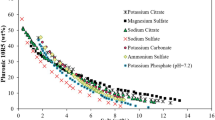Abstract
This paper presents the evaluation of some important parameters for the purification of phycocyanin using ion exchange chromatography. The influences of pH and temperature on the equilibrium partition coefficient were investigated to establish the best conditions for phycocyanin adsorption. The equilibrium isotherm for the phycocyanin–resin system was also determined. The separation of phycocyanin using the Q-Sepharose ion exchange resin was evaluated in terms of the pH and elution volume that improved the increase in purity and recovery. The highest partition coefficients were obtained in the pH range from 7.5 to 8.0 at 25 °C. Under these conditions the equilibrium isotherm for phycocyanin adsorption was well described by the Langmuir model, attaining a Q m of 22.7 mg/mL and K d of 3.1 × 10−2 mg/mL. The best conditions for phycocyanin purification using the ion exchange column were at pH 7.5 with an elution volume of 36 mL, obtaining 77.3% recovery and a 3.4-fold increase in purity.





Similar content being viewed by others
Abbreviations
- C 0 :
-
initial phycocyanin concentration in the liquid phase (mg/mL)
- C :
-
phycocyanin concentration in the liquid phase (mg/mL)
- C * :
-
equilibrium phycocyanin concentration in the liquid phase (mg/mL)
- P :
-
purity ratio (A 615/A 280)
- f :
-
partition coefficient
- K d :
-
dissociation constant (mg/mL)
- PC:
-
phycocyanin concentration (mg/mL)
- Q m :
-
maximum binding capacity of the resin (mg/mL)
- Q * :
-
equilibrium phycocyanin concentration in the solid phase (mg/mL)
- V :
-
volume (mL)
References
Abalde J, Betancourt L, Torres E, Cid A, Barwell C (1998). Purification and characterization of phycocyanin from the marine cyanobacterium Synechococcus sp. IO9201. Plant Sci 136:109–120
Babu BR, Rastogi NK, Raghavarao (2006). Mass transfer in membrane distillation of phycocyanin colorant and sweet-lime juice. J Memb Sci 272:58–69
Barboza M, Almeida RMRG, Hokka CO (2002). Intrinsic kinetic parameters of clavulanic acid adsorption by ion-exchange chromatography. Ind Eng Chem Res 41:5789–5793
Batista AP, Raymundo A, Sousa I, Empis J (2006). Rheological characterization of coloured oil-in-water food emulsions with lutein and phycocyanin added to the oil and aqueous phases. Food Hydrocolloids 20:44–52
Bennett A, Bogorad L (1973). Complimentary chromatic adaptation in a filamentous blue-green alga. J Cell Biol 58:419–435
Bermejo R, Alvárez-Pez JM, Acién FG, Molina E (2002). Recovery of pure B-phycoerythrin from the microalga Porphyridium cruentum. J Biotechnol 93:73–85
Bermejo R, Acién FG, Ibánez MJ, Fernández JM, Molina E, Alvarez-pez JM (2003). Preparative purification of B-phycoerythrin from the microalga Porphyridium cruentum by expanded-bed adsorption chromatography. J Chromatogr B 790:317–325
Cano T, Offringa ND, Willson RC (2005). Competitive ion-exchange adsorption of proteins: competitive isotherms with controlled competitor concentration. J Chromatogr A 1079:116–126
Chase HA (1984). Affinity separations utilizing immobilized monoclonal antibodies––a new tool for the biochemical engineer. Chem Eng Sci 39:1099–1125
Cherng SC, Cheng SC, Tarn A, Chou TC (2007). Anti-inflammatory activity of c-phycocyanin in lipopolysaccharide-stimulated RAW 264.7 macrophages. Life Sci 81:1431–1435
Costa JAV, Linde GA, Atala DIP, Mibileli GM, Krüger RT (2000). Modelling of growth conditions for cyanobacterium Spirulina platensis in microcosms. World J Microbiol Biotechnol 16:15–18
Costa JAV, Colla LM, Duarte PF, Kabke K, Weber A (2002). Modelling of Spirulina platensis growth in fresh water using response surface methodology. World J Microbiol Biotechnol 18:603–607
Harsa S, Furusaki S (1994). Separation of amyloglucosidase using B-cyclodextrin/chitosan. Sep Sci Technol 29:639–650
Lan Q, Bassi AS, Zhu JX, Margaritis A (2001). A modified Langmuir model for the prediction of the effects of the ionic strength on the equilibrium characteristics of protein adsorption onto ion exchange/affinity adsorbents. Chem Eng J 81:179–186
Liu LN, Chen XL, Zhang XY, Zhang YZ, Zhou BC (2005). One-step chromatography method for efficient separation and purification of R-phycoerythrin from Polysiphonia urceolata. J Biotechnol 116:91–100
Niu JF, Wang GC, Lin XZ, Zhou BC (2007). Large scale recovery of C-phycocyanin from Spirulina platensis using expanded bed adsorption chromatography. J Chromatogr B 850:267–276
Patel A, Mishra S, Pawar R, Ghosh PK (2005). Purification and characterization of C-phycocyanin from cyanobacterial species of marine and freshwater habitat. Protein Expr Purif 40:248–255
Patil G, Chethana S, Sridevi AS, Raghavarao KSMS (2006). Method to obtain C-phycocyanin of high purity. J Chromatogr A 1127:76–81
Pessoa A Jr, Hartmann R, Vitolo M, Hustedt H (1996). Recovery of extracellular inulinase by expanded bed adsorption. J Biotechnol 51:89–95
Reddy MC, Subhashini J, Mahipal SVK, Bhat VB, Reddy PS, Kiranmai G, Madyastha KM, Reddanna P (2003). C-phycocyanin, a selective ciclooxygenase-2 inhibitor, induces apoptosis in lipopolysaccharide-stimulated RAW 264.7 macrophages. Biochem Biophys Res Commun 304:385–392
Reis A, Mendes A, Lobo-Fernandes H, Empis JA, Novais JM (1998) Production, extraction and purification of phycobiliproteins from Nostoc sp. Bioresour Technol 66:181–187
Santiago-Santos M, Ponce-Noyola T, Olvera-Ramirez R, Ortega-López J, Cañizares-Villanueva RO (2004). Extraction and purification of phycocyanin from Calothrix sp. Proc Biochem 39:2047–2052
Sarada R, Pillai MG, Ravishankar GA (1999). Phycocyanin from Spirulina sp: influence of processing of biomass on phycocyanin yield, analysis of efficacy of extraction methods and stability studies on phycocyanin. Proc Biochem 34:795–801
Silveira ST, Burkert JFM, Burkert CAV, Costa JAV, Kalil SJ (2007). Optimization of phycocyanin extraction from Spirulina platensis using factorial design. Bioresour Technol 98:1629–1634
Vonshak A (1997) Spirulina platensis (Arthospira): physiology, cell biology and biotechnology. Taylor and Francis, London
Acknowledgments
We wish to acknowledge the support of the Coordenação de Aperfeiçoamento de Pessoal de Nível Superior (CAPES) and CNPq for their support of this work.
Author information
Authors and Affiliations
Corresponding author
Rights and permissions
About this article
Cite this article
Silveira, S.T., de Menezes Quines, L.K., Burkert, C.A.V. et al. Separation of phycocyanin from Spirulina platensis using ion exchange chromatography. Bioprocess Biosyst Eng 31, 477–482 (2008). https://doi.org/10.1007/s00449-007-0185-1
Received:
Accepted:
Published:
Issue Date:
DOI: https://doi.org/10.1007/s00449-007-0185-1




